New joseki
I recently saw a new move in a recent game between Takemiya Masaki 9p and Yamada Takuji 7p. The new move is Black 5 in the following diagram (where A and B are the normal joseki moves, and C can be considered "tricky move" and is rarely seen):
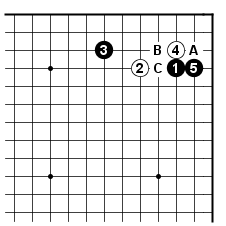
I don't know of any established joseki in this case, so I searched my game collection trying to find other instances of this move being played in professional games. I only found 6 games (4 of which had other stones nearby, so only in 2 games from my collection was this move played in isolation). This article is an initial analysis of mine about this joseki.
The first question when faced with an unexpected move is: "Why?" (Why did the opponent play this move, what is the purpose?
In a sense, Black is playing solidly at 5 instead of A to allow White fewer forcing moves in the area. It is similar to the style to adopt while attacking: play solidly, don't touch the opponent stones.
White might be tempted to "punish" Black for not playing A, and play at A himself. That is not good though: Black cuts at B and White has no good continuation.
Another thing to notice is that Black threatens to connect underneath at A in the next diagram. That shouldn't come as a surprise anyways, given that Black's purpose behind the initial approach move (hasami) is the same. White tried to prevent that with his 3x3 attachment, and Black keeps the threat alive with Black 5 in the previous diagram.

Another thing to do when analysing new moves is to compare them to known sequences. In this case, the new Black 5 can be compared with the normal hane in the next diagram. After the Black hane at 5, White has no choice but to retreat at 6, and Black plays next either at A (the old joseki), or develops faster with Black 7, a Korean innovation of the past few years to which White normally replies at B, threatening A next.
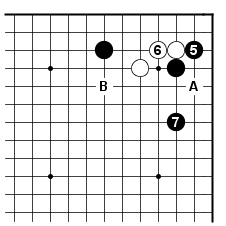
If White replies the new Black 5 the same way by retreating with 6 in the following diagram and Black extends at 7, White has nothing to aim at in Black's formation on the right side, so from that point of view White can be dissatisfied.

For the reason shown in the previous diagram, White has to find another line of play. Here are the continuations found in the (few) professional games where I saw this new move played:


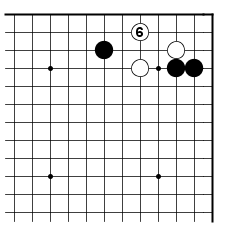
First, notice that in all variations White prevents Black from connecting his stones on the 3rd line.
In the first variation White plays at the head of Black's 2 stones. The following diagram shows the continuation for one of the games. White 8 makes miai for White to put pressure on the Black on the upper side or to put pressure on the right side.
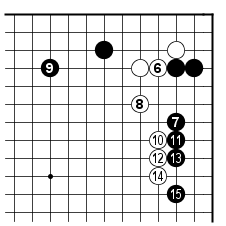
In the second variation White played tsuke against the lonely Black stone, again getting out into the center while preventing Black to connect underneath.

There were 2 different games with this variation, and Black chose a different continuation in each. Both may remind one of (well) known variations from the normal tsuke-nobi joseki played against a hoshi stone. First the one similar to the most common tsuke-nobi joseki variation (White has to do something to protect against the cut after Black 11):

Then the oher variation similar to the tsuke-nobi joseki (Black has to defend his right side stones next, and White can attack on the upper side):

And finally the third way for White to deal with Black's new move (and the one chosen by Takemiya Sensei) is to "jump downwards" with White 6 in the following diagram. Black chose to play the 7-10 forcing sequence (7 is a sacrifice); the advantage of this, as I see it, is to prevent White from making eye shape with B after White 6 (if White plays at B after Black 11, Black C makes D and E miai); the disadvantage is that the extra stones of White 8 and especially 10 make White strong on the outside, and enables White to attack with 12.

Here is the continuation: Black 13 is a very aggressive move and the fight already looks like middle game now.
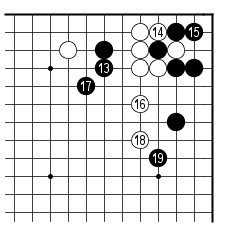
In conclusion: which of the 3 White responses to Black's unusual move to choose? It depends on the whole board, of course, but from a local standpoint I think I would personally chose the second one, which resembles the tsuke-nobi joseki, since it keeps things simple.
